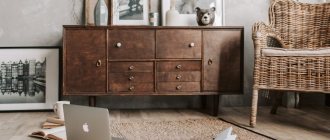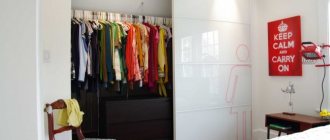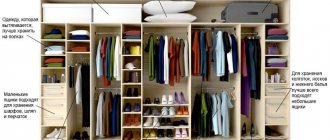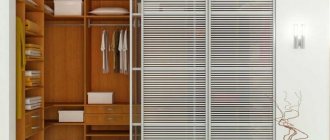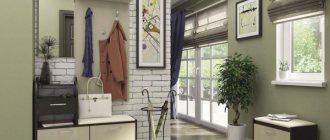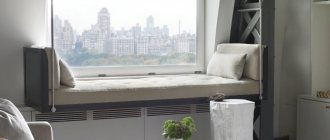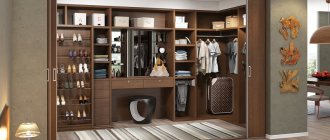A separate room for storing clothes is gradually ceasing to be an attribute of luxury and the prerogative of a large private home. So, for example, in a city apartment you can organize a small dressing room from the pantry - this will save space in other rooms, will cost less than a custom-made wardrobe and will allow you to organize convenient storage of things. In this article we tell you how to do it yourself step by step.
What to consider when planning?
First you need to measure the area of the pantry.
- If its size is 1x1.5 m or more, the space is suitable for arranging a dressing room.
- Now let’s decide on the location of the shelves: to install them on one side, the width of the wall should be 1.3 m. To place the shelves on both sides, 1.5 - 2 m will be required.
- The dressing room in the pantry is a closed, unventilated room. To preserve clothes, you should provide them with ventilation, and to make changing clothes easier, provide lighting.
Thus, you can turn an ordinary pantry into a dressing room even in a Khrushchev - the main thing is to take into account all the features and carefully consider the storage system.
The photo shows a small dressing room in a former storage room, separated from the bedroom by a curtain.
Finishing materials
Regardless of the type of materials chosen, the requirements for them are the same:
- Smooth surface. The walls in the room should be smooth. This will avoid snags and tangles on clothing;
- High quality. Whitewashing, low-quality paint, and cheap wallpaper can leave marks on things. They will be quite difficult to get rid of;
- Resistant to odor and moisture absorption. Together with forced ventilation, this finishing property will help avoid the appearance of mold and unpleasant odors;
- Easy to care for. All surfaces must be washable. Wet cleaning should be carried out at least once a week.
It is quite possible to build a small dressing room yourself. To do this, you will need to purchase all the necessary materials, based on your own calculations and desires.
Wardrobe system options
There are several types of “filling” for a dressing room, and each has its own advantages.
- Frame. A metal structure consisting of racks or chrome-plated pipes to which shelves and rods are fixed. The base is attached to the ceiling and floor, so the frame is very durable. This is an excellent option for a compact dressing room from a pantry, since the design does not have “extra” side walls that take up valuable centimeters.
- Panel. A storage system consisting of wide panels that are securely screwed to the wall. It is on them that shelves and drawers are attached parallel to each other.
- Mesh. A modern design consisting of lightweight metal honeycombs or gratings that are fixed to the wall using special brackets. Installation is quite simple.
- Corpus. One of the main advantages of such a system is the ability to assemble it yourself. It is sustainable and aesthetic. For each group of clothing and accessories, you can allocate its own place. Its disadvantage is that the side partitions take up useful space.
The photo shows a spacious dressing room in the pantry with a frame storage system made of light chipboard.
When choosing a storage system, it is worth considering the weight and strength of the structure - will the shelves support everything you need? In addition, you should pay attention to the mobility of the system - is it planned to be transported? Will it need modification?
The photo shows a frame structure in a pantry with open shelves, upper and lower rods, and a cabinet with drawers.
Installing shelves
Shelves must support the weight of clothing and not move when touched by a person. Safety and ease of use depend on the correct installation of parts. Structures mounted on dowels often turn over.
A reliable and safe option for wardrobe rooms from the pantry are fasteners made from steel corners or timber. Markings are made on the wall with a pencil, then the parts are fixed with a screwdriver and self-tapping screws, and shelves are installed. The edges of the elements are pre-treated, protecting clothes from damage.
Fastening options for shelves Source alta-group.com.ua
Furniture mensolo holders are used as fasteners. If the structure must withstand high loads, then preference is given to a decorative corner. “Pelican” looks beautiful in structures made from materials of different thicknesses or raw materials (wood, steel). To fix shelves made of composites, hidden (invisible) models are used. For thin parts, options with FIX fasteners are suitable.
Device for shelves Source ozone.ru
How to arrange a dressing room?
After calculating the area of the room and choosing the material for the filling, you need to plan the placement of shelves and hangers in such a way that it is convenient to use the dressing room.
Location of storage systems
The choice of configuration is primarily influenced by the size of the pantry. The most compact (and less roomy) option is placement along one wall. With a well-thought-out layout of shelves and drawers, a small area will not be a problem, but will allow you to fit all your things and organize the perfect order in your mini dressing room.
If the pantry is long, then it is best to arrange the storage systems in the shape of the letter “L”. In addition to clothes and shoes, you can also store larger items in it: travel bags, clothes dryer, bulky boxes or bags with seasonal items. The width of the shelves should be such that there is a narrow distance for passage to the far corner of the dressing room.
For larger storage rooms, the optimal internal organization is in the shape of the letter “P”, when three walls are involved.
A small symmetrical pantry allows you to arrange the shelves diagonally. Triangular (corner) placement is not very functional, but sometimes it is the only way out.
The photo shows an example of placing shelves along one wall.
Dressing room lighting
An illuminated dressing room from the pantry is a completely different level of convenience than a small, dim room. Thanks to the light, using the dressing room becomes much easier and more enjoyable. One of the most budget options is an LED strip with automatic switching on when a person moves. LED lamps are very bright, safe for confined spaces, and easy to install in any convenient place.
In addition to ribbons, you can use small ceiling lamps or spotlights with a rotating mechanism. The main thing is that electrical appliances do not interfere with getting out linen and clothes.
Ventilation
The lack of circulated air in the dressing room threatens the appearance of mold, moths and unpleasant odors. Therefore, it is advisable to equip the room with ventilation. The storage room usually borders the living room, bedroom or bathroom, so for air circulation, a hole is made in the wall and covered with a grill. Air is removed through the gap under the door or the flow grille.
A more complex method is to install special devices: air vents. To do this, during renovations, professionals are invited to install a separate ventilation line in the dressing room.
Doorway design
There are several ideas to aesthetically close the opening of a dressing room made from a pantry. The most common is a swing door. Unfortunately, it takes up a lot of free space on the outside. If the opening is wide, two small doors can be used.
Sliding doors on profile guides will help save space. You can order a canvas to match the color of the walls or decorate it with a mirror.
The easiest way to close a doorway is to install a curtain rod and drape the dressing room with thick fabric to match the style of the interior.
The photo shows a dressing room converted from a storage room, the doors of which were replaced with textiles. This budget-friendly way to design an opening does not prevent it from looking stylish and aesthetically pleasing.
Interior decoration
So, how can you turn a small closet into a dressing room? Immediately after creating a graphic plan, you should begin interior decoration of the room. Renovating this room will not cost much, since it is quite small. For floor finishing, you should choose wear-resistant materials: laminate, parquet, tiles, high-class linoleum. The ceiling can be decorated with foam boards, paint, or stretch film.
An ideal option for a small dressing room is to install an exhaust fan or air conditioner.
For wall decoration, ordinary wallpaper, paint, and wooden modules are suitable. One of the walls can be decorated with mirror modules. As for the color scheme, you should give preference to light shades and glossy surfaces. This will make it possible to visually enlarge the space and make the room more comfortable.
The dressing room is a place that is closed most of the time. Therefore, it must be well ventilated to prevent the appearance of dampness and mold.
Taking into account the areas in the dressing room
According to the rules of ergonomics, it is advisable to divide the interior space of the dressing room into three zones.
The topmost shelves are intended for seasonal items: hats, gloves. Unneeded outerwear is also removed there if the material allows it to be folded several times or packed in vacuum bags. A separate shelf is allocated for bed linen. Another one is for suitcases. As a rule, the higher things are located, the less often they are reached.
The middle zone is reserved for casual clothing. Rods are hung to hang dresses, blouses and suits; Shelves are installed for jackets, boxes and baskets, and drawers are installed for small items and accessories. It is convenient if there are dividers for underwear.
The lower section of the dressing room is allocated for storing shoes, bags and a vacuum cleaner. If there is not enough space for trousers in the middle zone, they can be placed below.
The photo shows a detailed description of the three functional zones of the interior space of the dressing room.
The dimensions of the shelves must be determined in advance. It happens that due to the large number of things, the standard depth and height are not suitable, then it is worth taking into account the dimensions of the previous storage location. Were there enough shelves for clothes? Did large items fit? It may be worth adding hooks or open shelves to accommodate the whole family's wardrobe.
Self-installation of structures
Experts also give advice on how to make a dressing room with your own hands. It's quite economical and simple. You don’t need to be a super-skilled craftsman to pave several shelves or put together a rack to fit the size of the side of the balcony.
And to install a crossbar for hangers, you only need material, fastening and a few efforts.
How to do it yourself?
When renovating, you can save a lot if you convert the pantry into a dressing room yourself.
Tools and materials
For finishing you will need:
- Roulette.
- Plaster.
- Sandpaper.
- Putty knife.
- Putty.
- Primer.
- Wallpaper with glue or paint with a roller and brushes.
- Floor covering (laminate, linoleum or parquet).
To create shelving you will need:
- Wooden boards or chipboard.
- End tape.
- Jigsaw.
- Screwdriver, dowels and screws.
- Metal furniture corners.
- A clothes rail and special fastenings at both ends.
- Hammer.
- Self-tapping screws with dowels, screwdrivers.
- Pencil.
- Level.
- Angle clamp.
The type of lighting and ventilation you choose depends on your budget and the location of your closet.
Step-by-step instruction
To make a dressing room in a pantry with your own hands, you need to follow a certain sequence. Let's get started:
- We dismantle the pantry door. We completely clean the interior space, including removing old finishing materials. If necessary, level the walls with plaster.
- We carry out finishing work. The ceiling is painted and a suitable covering is laid on the floor. The walls are covered with paint or wallpaper. It is necessary to choose modern paint compositions that do not stain clothes. Wallpaper must be washable. It is better to decorate your future dressing room in light colors. If you plan to install cabinet furniture, the finishing can be done inexpensively, since it will not be visible anyway. At this stage, ventilation and lighting are done.
- We take measurements for the manufacture of shelves. First you need to plan their location, draw a sketch, then draw up a detailed drawing. The number of shelves, rods and the dimensions of the racks depend on the real needs of the owner of the house, we will give only approximate figures: the height of the upper compartment is 20 cm, the middle one is about one and a half meters, the lower one is 40 cm. The length is determined based on the number of things and free space, the depth is in according to the size of the hanger plus 10 cm (total approximately 60 cm).
- Let's start cutting the laminated chipboard. This material is considered optimal for making a homemade shelving unit. It is not afraid of moisture and has high strength indicators. In addition, the slabs look aesthetically pleasing, imitating a wooden surface. The cutting is done with a jigsaw using sharp chipboard files. It is necessary to increase the speed, reduce the feed and set the pumping to 0. An even simpler solution is to cut it in the store when purchasing the material. Remove roughness on the edges with sandpaper.
- We fix the sides to the wall. To do this, mark vertical lines on the walls of the dressing room in accordance with the drawing. We fix 5 metal corners along the line at the same distance from each other (drill mounting holes, hammer in dowels, fix the corners with a screwdriver). We install the side panels from laminated chipboard, securing them to the corners with self-tapping screws.
- We make horizontal markings. We fix the shelves using small furniture corners: screws with dowels fix them to the wall, and wood screws to the chipboard.
- We continue to assemble the rack:
- We install the rod, securing the brackets with self-tapping screws between the two sidewalls.
- The pantry remodel is complete.
The photo shows a do-it-yourself dressing room, converted from a storage room.
Lighting and ventilation
The former storerooms of apartment buildings do not have windows, so when drawing up a dressing room design, you should consider the correct location of lamps and ventilation holes. During operation, a specific room will always be saturated with skin particles and dust.
If the room borders the street, you can create natural ventilation by making small valves near the floor and under the ceiling, which will ensure the supply of fresh air and the outflow of exhaust air. This method can also be used when ventilation ducts are located close together. To increase the air exchange rate, fans are installed. The influx of oxygen is ensured naturally, and the removal through forced exhaust. The size of the holes and the speed of movement of air masses are calculated based on the size of the dressing room.
Any dressing room requires a large number of clothes and shoes placed in their place. You can quickly find the necessary clothes and evaluate the right combination of colors only in bright light. It would be better if it was multi-zone lighting. Several lamps are placed on the ceiling, a rotating lampshade near the mirror, and LED strips above a bar with hangers.
Features of organization for a small pantry
A dressing room is considered compact if it occupies only 3 square meters. To accommodate as many things as possible, you can simply turn your pantry into a large closet.
If desired, part of the walls of the storage room is demolished and the room is expanded using drywall. Unfortunately, this reduces the area of the living room, which is especially critical in a one-room apartment. The redevelopment must be legalized in the BTI.
The photo shows a pantry-wardrobe, the modest area of which does not allow for a full-fledged dressing room.
But if instead of a pantry you plan to arrange a dressing room, you need to provide a convenient passage, reduce the depth of the shelves, and provide lighting. You will most likely have to abandon built-in drawers and use a lightweight frame storage system. To use every free centimeter, you can attach additional hooks, hang textile pockets or baskets. It’s also worth leaving room for a stool so you can easily reach the top shelves.
The photo shows a compact walk-in closet located in the bedroom.
Using Tools
When ensuring proper storage of things, it is impossible to do without specific elements (devices) that ensure they are kept in optimal form.
Currently, you can easily select the following convenient modern devices:
- pants and skirts with fixing clips and rubberized inserts;
- organizers with hangers and crossbars of various types for orderly arrangement of clothes;
- compact brackets for storing ties and belts;
- pantograph (clothing lift), which facilitates laying out clothes at any height (from floor to ceiling) and picking them up without climbing or bending towards the floor;
- compact shoe modules in the form of organizers or stands;
- organizer for storing bags and handbags.
Interior design ideas
It is worth paying special attention to mirrors - they will come in handy not only in a cramped dressing room, but also in a spacious room. A full-length mirror is useful when changing clothes; in addition, it visually expands the space and increases the amount of light.
The photo shows a large mirror that is mounted on the inside of the movable door, which makes it mobile and easy to use.
Another useful device is installing an ironing board in the dressing room. To do this you will need lighting, an outlet and a place for an iron.
Sometimes a dressing room in a closet becomes not only a storage place for things, but also a place for privacy, where you can put yourself in order, choose the right look, get ready for the work day or, conversely, for relaxation. This is why people all over the world value their cozy corners so much and try to furnish them with taste.
The photo shows a folding ironing board built into the wardrobe system.
Stylistic and color design
You can create an expressive room from a simple pantry if you properly design the surfaces and make good accents on the contents. A certain style is set not only by shelving structures, but also by their color, location features, and design. You can decorate the room in accordance with the following stylistic directions:
- Classic. Full-fledged facades and sliding wardrobes would be appropriate. The finish should be clear, without unnecessary details. The walls are plain, painted or wallpapered in pastel colors, the floor is made of natural materials (stone, wood). Furniture is only necessary and functional, for example, a table, a small ottoman.
- Eco style. The most peaceful design should not be overloaded with useless details. Only natural materials are used for finishing surfaces and as furniture materials.
- Minimalism. No accessories or decor. Only open strict shelves. Color: white-black, beige, brown.
- Techno. Cool, thoughtful style. The dressing room has only straight lines, many drawers with fancy fittings, and metal spotlights. Rough materials are used for finishing: metal, glass.
- High tech. Suitable for spacious walk-in closets. Advanced technologies and the latest materials are used to furnish the rooms. Lots of glass, plastic, metal. The colors mainly present are grey, metallic and white.
- Fusion Allows you to connect several directions at once. You can combine angular shelving and a fabric lampshade, plastic furniture and wooden flooring. A combination of a bright textile screen and a shabby chic dressing table would be appropriate.
Briefly about the main thing
A small wardrobe can be arranged in various utility rooms:
- Pantry.
- Attic.
- Loggias.
- In part of the room, for example, in a corner.
- When combining bathrooms.
- In a niche.
Its main advantages are the presence of a special storage area, greater order and organization of space in the house, improved interior design and the availability of clothes in one place. In this case, the layout of the room can be angular, U- or L-shaped, linear and parallel.
Its style is selected similar to the design of the room itself. For the arrangement, ready-made or custom-made storage systems are used, as well as modular furniture. You can make a mini-wardrobe with your own hands. To do this, you will need a clear plan for the dressing room and following the instructions. However, it is better to entrust its production to professionals.
Important nuances
When planning, designing, creating and arranging a mini-wardrobe, it is important to consider the following nuances:
- The composition of the equipment elements must be thought through at the project stage, otherwise the matter can be much more expensive.
- Light colors and good lighting, including spotlighting of important areas, will significantly increase the comfort of using the room.
- The minimum dimensions of a dressing room depend on the location of storage elements and the characteristics of their operation.
Rational storage system Source wp.com
- An ottoman or folding chair installed inside will help provide additional comfort.
- Drawers with dividers allow you to conveniently store small items.
- To quickly find things, it is better to use photo stickers or signatures.
